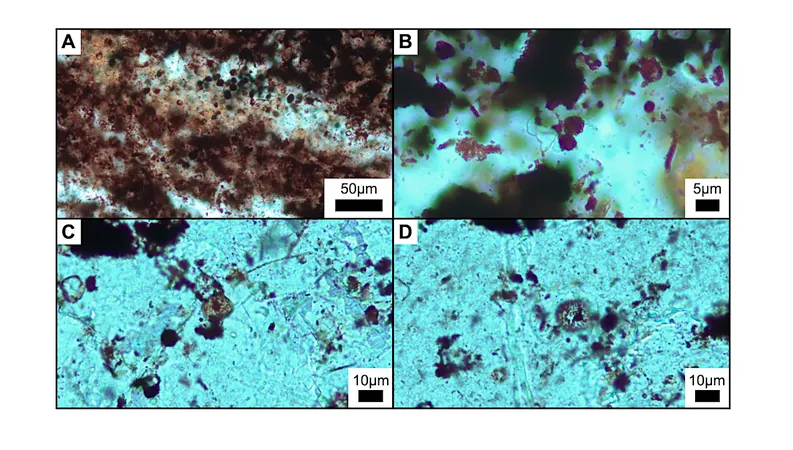
Ancient Iron-Oxidizing Bacteria Thrived in Shallow Marine Environments 1.88 Billion Years Ago
2024-12-19
Author: John Tan
Ancient Iron-Oxidizing Bacteria Thrived in Shallow Marine Environments 1.88 Billion Years Ago
A groundbreaking discovery has shed light on a remarkable period in Earth's history, approximately 1.88 billion years ago, when iron-oxidizing bacteria flourished in shallow-marine, subtidal environments. This phenomenon forms part of the narrative leading up to Earth's Great Oxidation Event (GOE), during which the majority of large iron formations (IFs) were deposited, marking a significant transformation in our planet's atmosphere and biosphere.
Following the GOE, the deposition of IFs declined for nearly 500 million years. However, a resurgence occurred around 1.88 billion years ago, marked by widespread deposition of shallow-water granular iron formations (GIF). This surge in deposition has been attributed to enhanced iron (Fe) supply in seawater, largely stemming from submarine hydrothermal venting, which coincided with the emergence of large igneous provinces.
Recent studies of iron-rich stromatolites from the Gunflint Formation in Canada propose that the microbial oxidation of seawater Fe2+ by microaerophilic iron-oxidizing bacteria (FeOB) played a critical role in GIF deposition during this era. Despite the prevalence of such stromatolites associated with these ancient iron formations, detailed paleontological and geochemical investigations have, until now, been limited primarily to the Gunflint Formation.
New insights have emerged from the Gibraltar Formation GIFs situated within the East Arm of Great Slave Lake, Northwest Territories, Canada. The combination of fossil morphology, rare earth element (REE) concentrations, and iron isotopic compositions supports the notion that Fe oxidation was primarily driven by FeOB at a redoxcline just above the fair-weather wave base.
Key findings include small positive anomalies in europium (Eu) and positive εNd values consistent with the upwelling of deep, Fe-rich, hydrothermally influenced seawater. The elevated levels of Fe2+ in conjunction with low atmospheric O2 during the late Paleoproterozoic created an optimal environment for these ancient bacteria to thrive, enabling them to precipitate iron oxyhydroxide in the shallow oceans. However, those conditions also posed challenges for cyanobacteria, which likely struggled to survive in a low-oxygen environment.
Further analyses revealed compelling evidence that iron-oxidizing bacteria could have relied on atmospheric O2 diffusion to oxidize Fe2+, further illustrating the delicate balance of ecological dynamics during this period. Moreover, thin-section photomicrographs of granular iron formations and stromatolites reveal intricate layers of Fe- and Si-rich sediments, providing insights into the interactions between mineral and microbial elements in these ancient ecosystems.
This extensive deposition of GIFs around 1.88 billion years ago marks a crucial episode of optimal biogeochemical conditions in Earth's history. With an upwelling supply of iron from deep oceans and low atmospheric O2, the shallow subtidal environments provided the perfect haven for iron-oxidizing bacteria, ultimately reshaping the planet's future.
The implications of such findings are profound, as they not only deepen our understanding of early microbial life on Earth but also enhance our perspective on how similar biogeochemical processes may assist in the search for life beyond our planet. Science continues to unveil the mysteries of our ancient Earth, inviting further inquiry into the complex interactions that have shaped life over billions of years.
Stay tuned as researchers delve deeper into this pivotal period, revealing more about the ancient microbes that may have paved the way for the diverse life forms we see today!



 Brasil (PT)
Brasil (PT)
 Canada (EN)
Canada (EN)
 Chile (ES)
Chile (ES)
 España (ES)
España (ES)
 France (FR)
France (FR)
 Hong Kong (EN)
Hong Kong (EN)
 Italia (IT)
Italia (IT)
 日本 (JA)
日本 (JA)
 Magyarország (HU)
Magyarország (HU)
 Norge (NO)
Norge (NO)
 Polska (PL)
Polska (PL)
 Schweiz (DE)
Schweiz (DE)
 Singapore (EN)
Singapore (EN)
 Sverige (SV)
Sverige (SV)
 Suomi (FI)
Suomi (FI)
 Türkiye (TR)
Türkiye (TR)